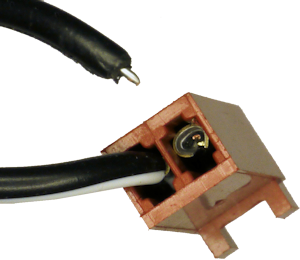In this experiment, a weather station is supplied power from a solar panel with a rechargeable battery backup. The charging circuit appears on the bottom of the previous page.
The battery pack contains three AA nickel-metal hydride (NiMH) rechargeable batteries. Although their nominal voltage is only 1.2 V each (3.6 V nominal for the pack of three), they start out at a little over 1.33 V each (4 V for the pack) upon being freshly recharged from an official battery charger. Each cell has a capacity of 2500 mAh.
The weather station logs data every minute, requires no less than 3.5 V unregulated input voltage, and consumes 1.3 mA of current on average. This is considered a low-drain or low-power device. In fact, the battery pack alone could run the device continuously for several months.

Graph of solar panel charging NiMH rechargeable batteries through a Schottky diode.
The graph shows the voltage of the battery pack and the solar panel for three nights and two days. During the night, the battery voltage drops from a high of 4.05 V to a low of 3.95 V due to powering the device and self-discharge.
During the day, the solar panel voltage fluctuates between 3.9 V (the battery pack supplies power to the device) and 4.25 V (the solar panel both powers the device and recharges the battery pack). However, sometimes, due to shadows or clouds, the battery pack seamlessly takes over powering the device.
Because the shape of the solar panel voltage appears similar for each day, it is likely that shadows of nearby fixed objects are the primary cause of solar panel voltage droops during this experiment.
The battery is supposed to back-up the solar panel. In the previous graph, we see that the battery does an excellent job in this role at night and when the solar panel is partially obscured. But will the solar panel continue to operate the device if the battery fails?

Failure due to broken battery wire.
I had the misfortune to test this circumstance due to a battery pack wire that suffered from metal fatigue during shipping or storage. The wire failed unexpectedly during device operation. Let this be a lesson to cut off the ends of pre-stripped wires and to strip your own ends before crimping them into a connector.

Graph of solar panel voltage when charging batteries versus not charging.
Starting on the left of the line graph, notice that the solar panel voltage is between 0.1 and 0.2 volts above the battery. Also, the solar panel voltage fluctuates while the battery slowly rises or is steady.
Suddenly, between the measurements sampled at 12:46 and the measurements at 12:47, both voltages rises to around 5 V. Even if it got very sunny, the solar panel is too small to charge the battery pack that quickly.
Instead, as we now know, the battery pack wire broke. Without the batteries to charge, the solar panel had a significantly lighter load, causing the voltage to rise. We can confirm that the battery pack is no longer in the circuit, as the battery voltage mirrors the panel voltage without delay. The difference between the voltages is the drop of diode D3.
This shows that the circuit allows the solar panel to continue to supply power even without the batteries. The effect of light shadows and clouds did not impact device operation, since the solar panel still had enough capacity now that it didn’t have to recharge the batteries. Of course, the device would shut down at nighttime due to the broken battery pack wire.
Is there an easy way for the circuit to monitor the power source voltages? On the next page you'll see that only a couple of resistors are required.